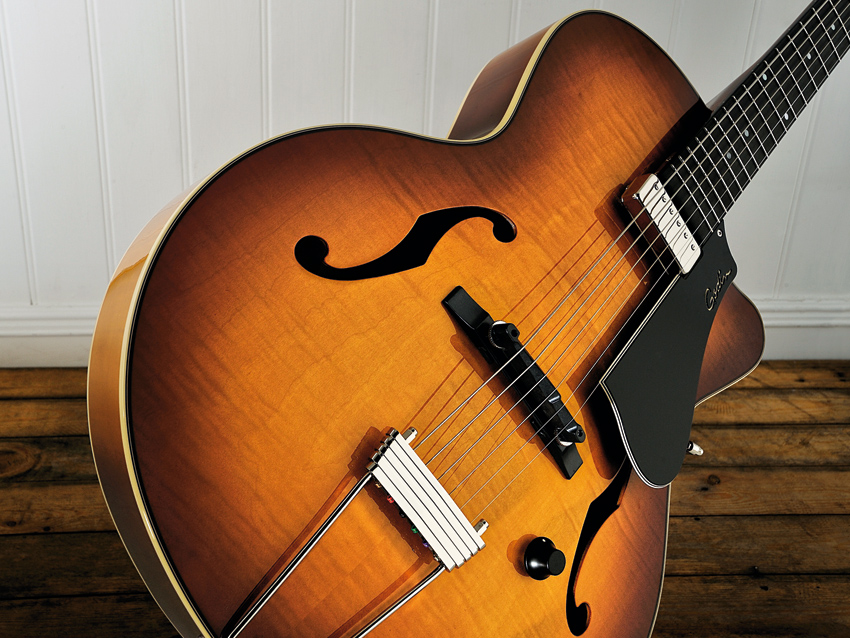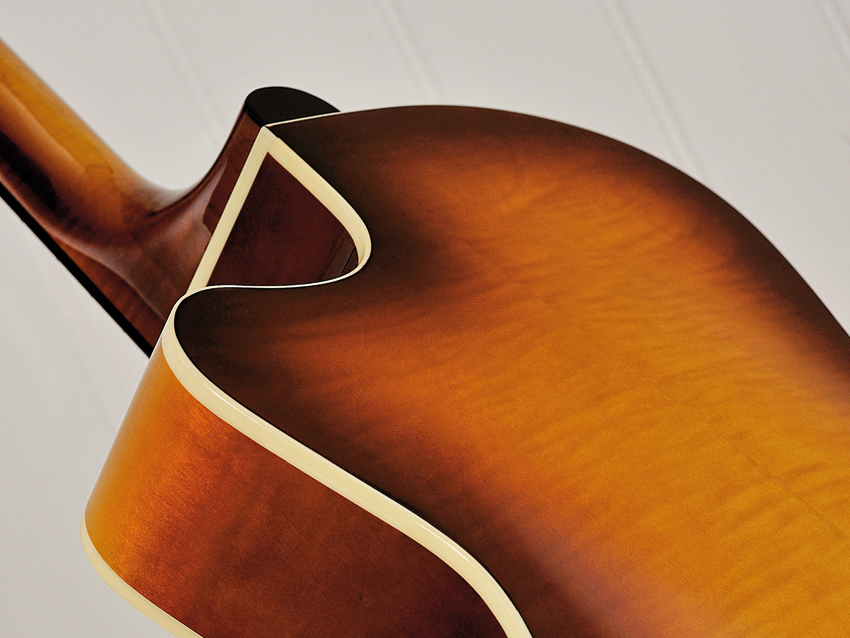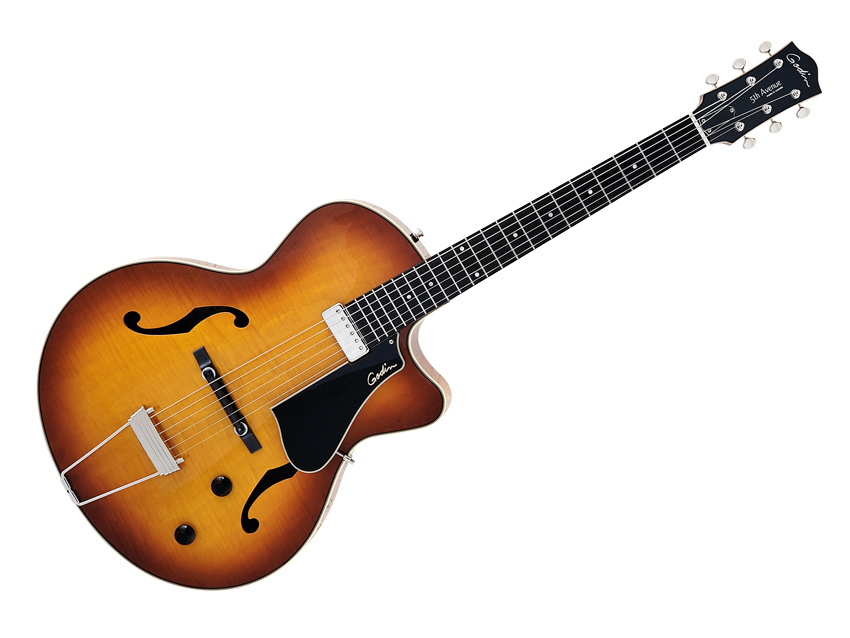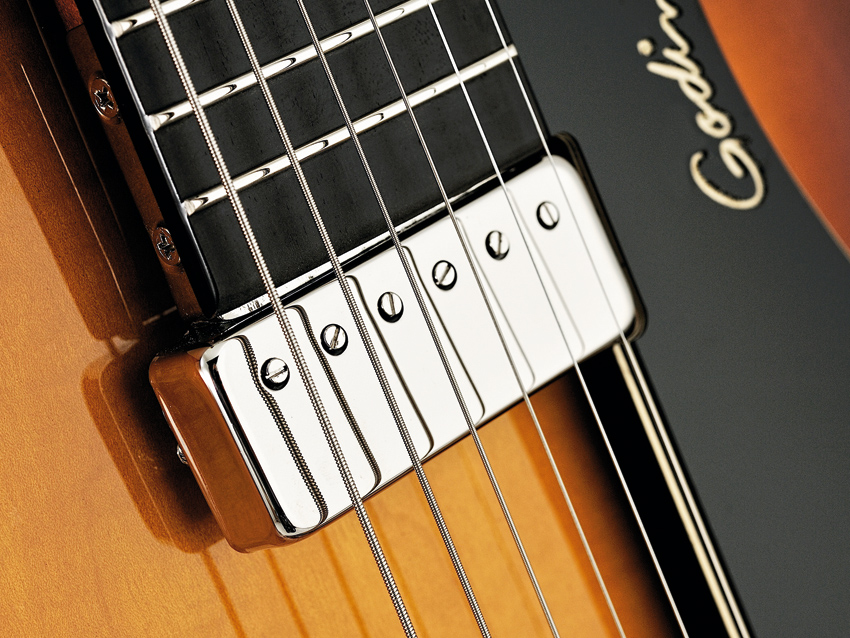MusicRadar Verdict
From humble beginnings, the 5th Avenue range now looks very attractive and the Jazz is a fine-quality addition.
Pros
- +
Luxuriant build; lightweight; classy feel; jazz-specific tonality both acoustically and plugged in.
Cons
- -
The neck pitch/bridge height is a little steep; side-mounted jack socket may work loose; price.
MusicRadar's got your back

Godin 5th Avenue Jazz

Godin 5th Avenue Jazz

Godin 5th Avenue Jazz

Godin 5th Avenue Jazz
From humble beginnings in 2008 as a non-cutaway acoustic archtop, Godin's 5th Avenue range has expanded into quite a family.
It's a clever concept - the same 406mm (16-inch) wide, 76mm (three-inch) deep (at the rim) body is used for all the models, with or without the rounded Venetian cutaway. At the head of the table is the Jazz, which comes complete with the aforementioned Venetian cutaway and an all-laminate body; constructed wholly from wild cherry on the all-black version or, as here, with added flame maple facings.
"Plugged in, the humbucker drops us right into that classic jazz territory with a full-bodied voice that has just the right amount of clarity to accurately reproduce complex voicings."
For the most part it's a tidily made and lightweight guitar, which at its asking price (expect to pay £1,659 on the street) it really should be. The 'bursting is very classic and evocative, nicely polished with clean cream plastic body edge binding and tidy inner black/white purfling on the top.
The neck joins the body at the 14th fret. The heel is laminated from a slightly mismatched piece of wood nicely 'hidden' by the 'burst finish; likewise the better-matched headstock splice.
It has an enjoyably mainstream, slightly square-shouldered 'C' section, the fingerboard cleanly fretted with small gauge 'vintage-style' frets and edge bound with black binding, which hides the fret slots from view. The actual neck angle seems a little steep to us, meaning that the adjustable top of the synthetic Graph Tech Tusq bridge sits some way from its foot.
Powering comes from a single Godin humbucker, which screws to the fingerboard end and floats over the top. Controls are conventional volume and tone units, complete with classy ebony knobs.
Classy is a word you keep coming back to when describing this guitar, especially the classic three-a-side headstock and those open-backed Waverly-style tuners. On top of that, of course, the price includes an excellent Godin-made TRIC case, which is lightweight and quite 'space age' in contrast to the look of the guitar itself.
Sounds
Out of the box, the action is a little on the high side (approx 2mm at the high E at the 12th fret and just under 2.5mm on the bass-side) and many would probably prefer some flat- as opposed to round-wound strings, also of a heavier gauge. However, as supplied, we have a very playable guitar with a typically laminate archtop-like pushy mid-range projection.
Plugged in, the humbucker drops us right into that classic jazz territory with a full-bodied voice that has just the right amount of clarity to accurately reproduce complex voicings. But not too much, so that higher string runs and licks sound thick and strong, not thin and stringy.
This tonality is replicated over numerous amps both electric and acoustic that we try. The only adjustments we need to make are in regard to the low end, which through some amps can be a little over-cooked.
Through the fuller range reproduction of an acoustic amp you'll hear more high-end clarity too and with some specific EQ'ing an altogether more acoustic voice emerges; though still with plenty of jazz thrum.
The 5th Avenue Jazz is certainly aimed at the more experienced jazz player. Yes, that neck pitch and bridge seem on the high side but the overall lightweight and classy build, not to mention good playability, a clean fingerboard with plenty of air to the string spacing, a lively acoustic resonance and very jazz-specific plugged-in voice all tick the right boxes.
Our only reservation is the price. Even at the lower street price it faces very stiff competition from the likes of Eastman, Peerless and Ibanez.
But we'd suggest you take time to play this one; maybe it'll speak to you, as it did with us. Price alone isn't everything, especially when a guitar sounds as right as this one.
Dave Burrluck is one of the world’s most experienced guitar journalists, who started writing back in the '80s for International Musician and Recording World, co-founded The Guitar Magazine and has been the Gear Reviews Editor of Guitarist magazine for the past two decades. Along the way, Dave has been the sole author of The PRS Guitar Book and The Player's Guide to Guitar Maintenance as well as contributing to numerous other books on the electric guitar. Dave is an active gigging and recording musician and still finds time to make, repair and mod guitars, not least for Guitarist’s The Mod Squad.
“A synthesizer that is both easy to use and fun to play whilst maintaining a decent degree of programming depth and flexibility”: PWM Mantis review
“I feel like that song had everything we needed to come back with”: Bring Me The Horizon’s Lee Malia on Shadow Moses, its riff and the secrets behind its tone, and why it was the right anthem at the right time
“I said, ‘Are we sure we can write a song about death?’”: The story of Mike + The Mechanics' classic No.1 The Living Years










